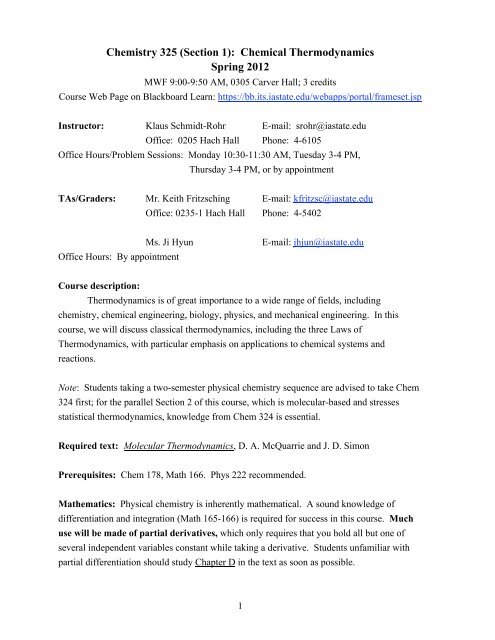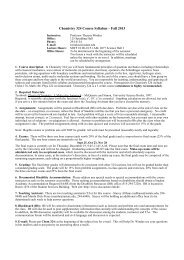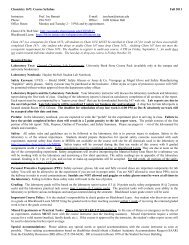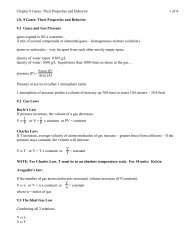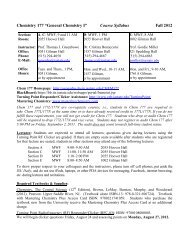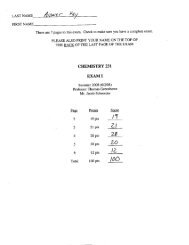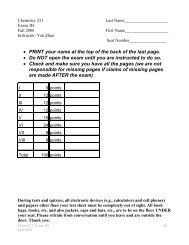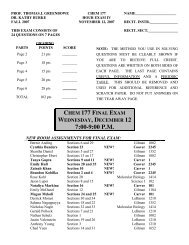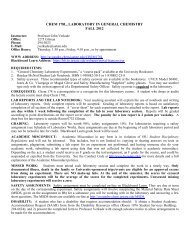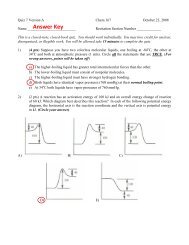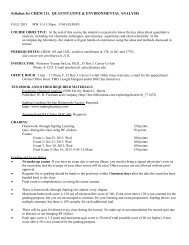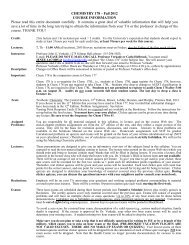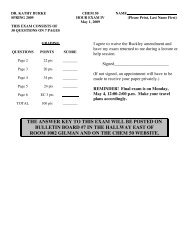Chem 325 A Syllabus
Chem 325 A Syllabus
Chem 325 A Syllabus
You also want an ePaper? Increase the reach of your titles
YUMPU automatically turns print PDFs into web optimized ePapers that Google loves.
<strong>Chem</strong>istry <strong>325</strong> (Section 1): <strong>Chem</strong>ical Thermodynamics<br />
Spring 2012<br />
MWF 9:00-9:50 AM, 0305 Carver Hall; 3 credits<br />
Course Web Page on Blackboard Learn: https://bb.its.iastate.edu/webapps/portal/frameset.jsp<br />
Instructor: Klaus Schmidt-Rohr E-mail: srohr@iastate.edu<br />
Office: 0205 Hach Hall Phone: 4-6105<br />
Office Hours/Problem Sessions: Monday 10:30-11:30 AM, Tuesday 3-4 PM,<br />
Thursday 3-4 PM, or by appointment<br />
TAs/Graders: Mr. Keith Fritzsching E-mail: kfritzsc@iastate.edu<br />
Office: 0235-1 Hach Hall Phone: 4-5402<br />
Ms. Ji Hyun<br />
Office Hours: By appointment<br />
E-mail: jhjun@iastate.edu<br />
Course description:<br />
Thermodynamics is of great importance to a wide range of fields, including<br />
chemistry, chemical engineering, biology, physics, and mechanical engineering. In this<br />
course, we will discuss classical thermodynamics, including the three Laws of<br />
Thermodynamics, with particular emphasis on applications to chemical systems and<br />
reactions.<br />
Note: Students taking a two-semester physical chemistry sequence are advised to take <strong>Chem</strong><br />
324 first; for the parallel Section 2 of this course, which is molecular-based and stresses<br />
statistical thermodynamics, knowledge from <strong>Chem</strong> 324 is essential.<br />
Required text: Molecular Thermodynamics, D. A. McQuarrie and J. D. Simon<br />
Prerequisites: <strong>Chem</strong> 178, Math 166. Phys 222 recommended.<br />
Mathematics: Physical chemistry is inherently mathematical. A sound knowledge of<br />
differentiation and integration (Math 165-166) is required for success in this course. Much<br />
use will be made of partial derivatives, which only requires that you hold all but one of<br />
several independent variables constant while taking a derivative. Students unfamiliar with<br />
partial differentiation should study Chapter D in the text as soon as possible.<br />
1
Grading:<br />
Homework problem sets (7 to 12): 10%<br />
Three hourly exams: 20% each<br />
Dates: Exam 1: Friday, Feb. 17<br />
Exam 2: Friday, Mar. 9<br />
Exam 3: Friday, Apr. 13<br />
Final exam (cumulative): 30%<br />
Tentative dates: Monday, April 30, 7:30 (-9:30) AM, or Wednesday, May 2.<br />
Make-up exams will be administered only in exceptional cases, which must be discussed<br />
with the instructor ahead of time or as soon as the conflict is known, and which<br />
absolutely require documentation. In some cases, at the instructor’s discretion, the missed<br />
exam may be waived and the final grade will then be based on the other exams and<br />
assignments, each taking on a proportionally higher weighting.<br />
Assignments: Homework problems will be handed out in class or made available through<br />
Blackboard Learn. Seven to ten homework sets will be assigned throughout the course of the<br />
semester, and are typically due one week after they are assigned. Answers to problem sets<br />
will usually be posted on the website one day after they are due. No credit will be given for<br />
homework sets handed in after the answers have been posted.<br />
Discussion and collaboration can be a valuable learning tool, and is therefore<br />
encouraged when you work through homework problem sets. Nevertheless, to gain a<br />
thorough understanding of the concepts addressed in the homework sets, each student must<br />
write up answers individually.<br />
Note: Illegible exams or problem sets will NOT be graded. All work must be presented<br />
reasonably neatly and logically.<br />
To encourage lecture attendance, simple in-class quizzes may be given and their scores<br />
incorporated with the homework scores.<br />
Disabilities: If you have a documented disability that requires assistance, you will need to<br />
go to the Disability Resource (DR) Office for coordination of your academic<br />
accommodations. The DR Office is located in the Student Services Building, Room 1076.<br />
The DR office phone number is 515-294-7220, TDD 515-294-6335.<br />
2
<strong>Chem</strong>istry <strong>325</strong>: <strong>Chem</strong>ical Thermodynamics (Spring 2012) Course Outline<br />
Topics of importance in later lectures are in bold. In other words, they represent the main<br />
“thread” of the course. Interesting results encountered 'along the way' are in italics. Topics<br />
not easily found in standard texts are underlined.<br />
1) Properties of Gases [Chapter 2 of McQuarrie and Simon]<br />
M Jan.9 Overview of the course. Ideal gas law; P, R, T units [2-1.]; Dalton’s law.<br />
W Jan.11 Nontrivial integrals (∫V dP) for ideal gases.<br />
F Jan.13 Real gases: P-V diagram [2-2.]; Van der Waals equation [2-2.].<br />
M Jan.16 {Martin Luther King Day}<br />
W Jan.18 Critical values & reduced quantities [2-3.];<br />
the principle of corresponding states of gases [2-4.].<br />
2) The First Law of Thermodynamics [Ch. 5]<br />
F Jan.20 Work w, heat q, and energy change ΔU [5-1.] in physics and chemistry.<br />
M Jan.23 Calculating P-V work: Bullet, piston weight, friction;<br />
chemical reactions in calorimeters.<br />
W Jan.25 Heat capacity [3-4.] and ΔU; how to determine q.<br />
F Jan.27 Inexact & exact differentials, line integrals [5-2.; Math Chapter D].<br />
M Jan.30 Manipulating derivatives and differentials; Euler’s chain rule.<br />
W Feb.1 Adiabatic expansion [5-4. & 5.]; the Otto combustion engine. (HW)<br />
F Feb.3 Enthalpy H [5-7.]; heat capacities [5-8. & 9.].<br />
Joule-Thompson cooling (HW).<br />
M Feb.6 Enthalpy changes in phase transitions [5-7.].<br />
W Feb.8 Hess’s Law; ΔH resulting from chemical reactions [5-10. to 12.].<br />
F Feb.10 Bond energies; why combustions are exothermic: O 2 is the true fuel!<br />
3) Entropy and the Second Law of Thermodynamics [Ch. 6]<br />
M Feb.13 The Second Law: Entropy is a state function [6-1. to 3.].<br />
Entropy changes for various processes [7-1. & 5.]; entropy of mixing.<br />
W Feb.15 Entropy and disorder; Trouton’s entropy change in phase transitions [7-3.];<br />
review.<br />
F Feb.17 Exam 1<br />
M Feb.20 S(0 K): The Third Law of thermodynamics [Ch. 7].<br />
Entropy changes in chemical reactions [7-9.].<br />
W Feb.22 Heat engines and their maximum efficiency [6-7.]: Carnot cycle.<br />
F Feb.24 Making heat flow from cold to hot: refrigerators.<br />
M Feb.27 Reversible and spontaneous processes;<br />
spontaneous processes and entropy increase in an isolated system [6-4.].<br />
W Feb.29 The Clausius inequality written correctly [6-4.];<br />
free energies and spontaneous processes [8-1. & 2.].<br />
4) Helmholtz and Gibbs Free Energies [Ch. 8]<br />
F Mar.2 Gibbs energy change & spontaneous chemical processes [8-1.].<br />
3
M Mar.5 Review of thermodynamic energies & their differential expressions [8-5.];<br />
Maxwell relations [8-3. & 5.].<br />
W Mar.7 The general equilibrium condition from chemical potentials.<br />
The Fundamental Relation of chemical thermodynamics. Review.<br />
F Mar.9 Exam 2<br />
{M Mar.12, W Mar. 14, F Mar. 16: Spring break}<br />
M Mar.19 T- and P-dependence of G [8-7. & 8.]; ΔG in phase transitions [p. 305/6].<br />
W Mar.21 Gibbs energy of mixing [10-4.]; Gibbs-Helmholtz equation [8-7.].<br />
5) The <strong>Chem</strong>ical Potential [some in Ch. 10]<br />
F Mar.23 The chemical potential µ i [9-3.] and spontaneous changes in composition;<br />
Partitioning into two phases; osmotic pressure (HW) [11-4.];<br />
G = Σ i µ i n i . [10-1.]; the Euler equation for U.<br />
M Mar.26 Fugacity [8-8.]; liquid-liquid mixtures & their vapors; Raoult’s law [10-4.].<br />
W Mar.28 Solution thermodynamics via the vapor chemical potential [10-3.];<br />
Henry’s law [10-5.]; non-ideal solutions [10-6.];<br />
activity & standard state [10-7. & 8.].<br />
6) <strong>Chem</strong>ical Equilibrium [Ch. 12]<br />
F Mar.30 Gibbs energy and chemical equilibrium [12-1. & 4.].<br />
M Apr.2 The equilibrium constant [12-2.].<br />
W Apr.4 Calculating equilibrium constants [12-3.].<br />
F Apr.6 Activity vs. concentration in chemical equilibria [12-11. & 12.].<br />
7) Electrochemistry [Ch. 13]<br />
M Apr.9 Derivation of the Nernst equation [13-4.].<br />
W Apr.11 Using the Nernst equation [13-6.]; review.<br />
F Apr.13 Exam 3<br />
M Apr.16 Batteries and fuel cells [13-12.].<br />
8) Phase Equilibria [Ch. 9]<br />
W Apr.18 One-component phase diagrams [9-1.]; triple and critical points.<br />
F Apr.20 The Clapeyron equation: Melting under pressure [9-3.].<br />
M Apr.23 The Clausius-Clapeyron equation: Vapor-pressure curve P Vap (T) [9-4.].<br />
W Apr.25 How to reach the critical point.<br />
F Apr.27 Course review<br />
M Apr.30 or W May 2 Likely dates of Final Exam<br />
Note: The dates on which the material will be presented are tentative<br />
(except for Exams 1-3).<br />
4


